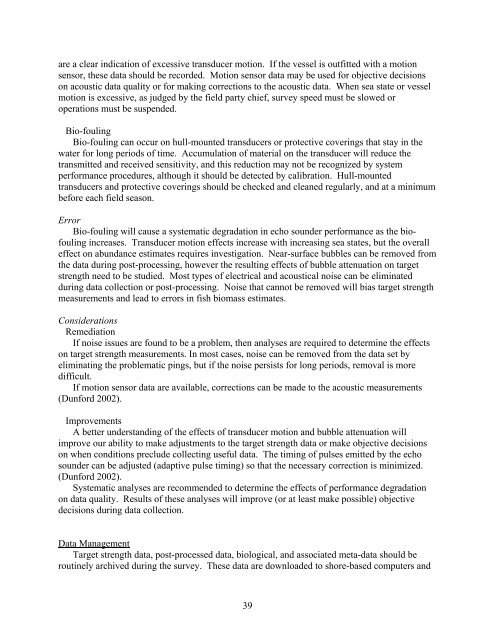NOAA Protocols for Fisheries Acoustics Surveys and Related ...
NOAA Protocols for Fisheries Acoustics Surveys and Related ...
NOAA Protocols for Fisheries Acoustics Surveys and Related ...
You also want an ePaper? Increase the reach of your titles
YUMPU automatically turns print PDFs into web optimized ePapers that Google loves.
are a clear indication of excessive transducer motion. If the vessel is outfitted with a motion<br />
sensor, these data should be recorded. Motion sensor data may be used <strong>for</strong> objective decisions<br />
on acoustic data quality or <strong>for</strong> making corrections to the acoustic data. When sea state or vessel<br />
motion is excessive, as judged by the field party chief, survey speed must be slowed or<br />
operations must be suspended.<br />
Bio-fouling<br />
Bio-fouling can occur on hull-mounted transducers or protective coverings that stay in the<br />
water <strong>for</strong> long periods of time. Accumulation of material on the transducer will reduce the<br />
transmitted <strong>and</strong> received sensitivity, <strong>and</strong> this reduction may not be recognized by system<br />
per<strong>for</strong>mance procedures, although it should be detected by calibration. Hull-mounted<br />
transducers <strong>and</strong> protective coverings should be checked <strong>and</strong> cleaned regularly, <strong>and</strong> at a minimum<br />
be<strong>for</strong>e each field season.<br />
Error<br />
Bio-fouling will cause a systematic degradation in echo sounder per<strong>for</strong>mance as the biofouling<br />
increases. Transducer motion effects increase with increasing sea states, but the overall<br />
effect on abundance estimates requires investigation. Near-surface bubbles can be removed from<br />
the data during post-processing, however the resulting effects of bubble attenuation on target<br />
strength need to be studied. Most types of electrical <strong>and</strong> acoustical noise can be eliminated<br />
during data collection or post-processing. Noise that cannot be removed will bias target strength<br />
measurements <strong>and</strong> lead to errors in fish biomass estimates.<br />
Considerations<br />
Remediation<br />
If noise issues are found to be a problem, then analyses are required to determine the effects<br />
on target strength measurements. In most cases, noise can be removed from the data set by<br />
eliminating the problematic pings, but if the noise persists <strong>for</strong> long periods, removal is more<br />
difficult.<br />
If motion sensor data are available, corrections can be made to the acoustic measurements<br />
(Dun<strong>for</strong>d 2002).<br />
Improvements<br />
A better underst<strong>and</strong>ing of the effects of transducer motion <strong>and</strong> bubble attenuation will<br />
improve our ability to make adjustments to the target strength data or make objective decisions<br />
on when conditions preclude collecting useful data. The timing of pulses emitted by the echo<br />
sounder can be adjusted (adaptive pulse timing) so that the necessary correction is minimized.<br />
(Dun<strong>for</strong>d 2002).<br />
Systematic analyses are recommended to determine the effects of per<strong>for</strong>mance degradation<br />
on data quality. Results of these analyses will improve (or at least make possible) objective<br />
decisions during data collection.<br />
Data Management<br />
Target strength data, post-processed data, biological, <strong>and</strong> associated meta-data should be<br />
routinely archived during the survey. These data are downloaded to shore-based computers <strong>and</strong><br />
39
















